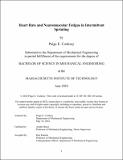| dc.description.abstract | Monitoring and regulating fatigue are essential tasks for the general well-being and success of competitive athletes. Many wearable fitness devices measure how strenuous workouts are based on time spent in each heart rate zone which represents cardiovascular difficulty. Despite having new adaptations for weight training, these devices do not have a way to quantify the fatigue of less aerobic, yet very strenuous workouts like sprinting. This paper investigates various heart rate metrics, including rate of heart rate increase/decrease, integrated heart rate, and one-minute heart rate recovery, of two well-trained subjects across a sprint-interval workout (2x50-meters, 3x100-meters, 2x50-meters) to determine if they are correlated with neuromuscular fatigue as quantified by the percent reduction in countermovement jump height after each repetition. Out of four workout trials, only one showed a significant relationship between the metrics, which were consistent across workouts for each subject, and fatigue, indicating that the analyzed metrics may not be a sound way to monitor fatigue in athletes. However, it is also possible that more subjects performing more trials of the workout could reveal additional relationships. A further study would be to perform a uniform sprint workout since a significant relationship did exist for one of the subjects across the sprint intervals of the same length (100-meters), indicating that such a workout may yield different results, but, once again, further data collection would be needed to draw conclusive statements. Regardless, other metrics such as muscle activity, velocity, acceleration, oxygen uptake, etc. should be considered for future research into quantifying neuromuscular fatigue in sprinting. | |
